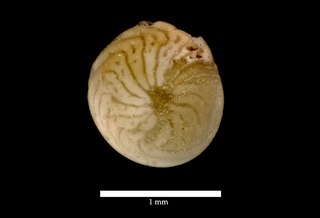Related Research Articles

The Globigerinina is a suborder of foraminiferans that are found as marine plankton. They produce hyaline calcareous tests, and are known as fossils from the Jurassic period onwards. The group has included more than 100 genera and over 400 species, of which about 30 species are extant. One of the most important genera is Globigerina; vast areas of the ocean floor are covered with Globigerina ooze, dominated by the shells of planktonic forms.

Globigerina is a genus of planktonic Foraminifera, in the order of Rotaliida. It has populated the world's oceans since the Middle Jurassic.

The Rotaliida are an order of Foraminifera, characterized by multilocular tests (shells) composed of bilamellar perforate hyaline lamellar calcite that may be optically radial or granular.

The Asterigerinacea is a superfamily of Foraminifera included in the order Rotaliida, proposed by Loeblich and Tappan in 1988.
Discorbacea, Discorboidea in recent taxonomies, is a superfamily of foraminifera,, with a range extending from the Middle Triassic to the present, characterized by chambers arranged in a low trochspiral; an umbilical or interiomarginal aperture, with or without supplementary apertures; and a wall structure that is optically radial.
Abathomphalus is a genus of foraminifera included in the Globotruncanid family.

Globigerinoidea is a superfamily of free-living, calcareous, planktonic foraminiferal protists that have lived in the open ocean since the Eocene. It is part of the suborder Globigerinina.
Miliamellus is a genus of Cenozoic benthic foraminifera with tests made of imperforate opaline silica. It is the only genus in the order Silicoloculinida and the family Silicoloculinidae. It is sometimes referred to by the junior synonym Silicoloculina.

Cibicides is a genus of cosmopolitan benthic foraminifera known from at least as far back as the Paleocene that extends down to the present.

Cassidulina is a genus of foraminifera described in the Treatise Part C., as having a free, lenticular test, with central boss of clear calcite on either side. Chambers are biserially arranged, enrolled planispirally with a subangular to keeled periphery. The wall is calcareous, hyaline (glassy), optically granular, perforate. The surface is smooth with a polished appearance. Sutures are radial to oblique, straight or curved. The aperture is a narrow arched slip at the base of the apertural face, partly closed by an apertural place.
Discorbis is a genus of benthic Foraminifera, that made its first appearance during the Eocene. Its present distribution is cosmopolitan.
Rosalina is a genus of foraminifera included in the rotaliid family Rosalinidae.
The Cassidulinacea is a superfamily of benthic amoeboid foraminifera in the order Rotaliida that has been extant from the Paleocene down to the present. Tests are composed of secreted, optically radial or granular, perforate calcite with chambers biserially coiled at least in the early part, Apertures are usually an interiomarginal slit, but may become terminal and may have secondary features.
Globulina is a genus of Foraminifera with an ovate to globular test, included in the Polymorphinidae, Notocariacea, that has been extant since the Middle Jurassic (Callovian).
Hedbergella is an extinct genus of planktonic foraminifera from the Cretaceous, described by Loeblich and Tappan, 1961, as:
Test free, trochospiral, biconvex, umbilicate, periphery rounded with no indication of keel or poreless margin; chambers globular to ovate; sutures depressed, radial, straight or curved; wall calcareous, finely perforate, radial in structure, surface smooth to hispid or rugose; aperture an interiomarginal, extraumbilical-umbilical arch commonly bordered above by a narrow lip or spatulate flap, ... Includes species otherwise similar to Praeglobotruncana but which lack a keel or poreless margin, hence is regarded as a separate genus rather than as a subgenus of Praeglobotruncana as by Banner and Blow (1959).
Buccella is a genus of late Cenozoic benthic foraminifera that made its first appearance during the Oligocene and is found living in recent oceans.
Halenia is a genus of recent discorbacean foraminifera. It contains only one species, Halenia legrandi The test is free, a low trochspire with a rounded periphery; wall calcareous, monolamellar. Chambers are subglobular, all visible on spiral side, only last volution visible on umbilical side; final chamber with an umbilical flap. Sutures are depressed, radial on umbilical side, curved to sinuate on spiral side, with sutural slits on both sides.
Gansserina is a genus of planktonic foraminifera, included in the globigerinid family Globotruncanidae, that had a fairly wide distribution in the Late Cretaceous (Maastrichtian). The type species is Gansserina gansseri.
Geinitzina is a genus of Foraminifera from the early Carboniferous (late Mississippian to the late Permian that may have extended into the Triassic. Chambers are uniserial, arranged in a single row, or line. Test wall is double layered. The outer layer is of hyaline radial calcite, and is light in color. The inner layer is of microgranular calcite, and is dark is color. Both layers are secreted by the protoplasm.
Sigmoilina is a miliolid genus, referring to the foraminiferal order Miliolida, characterized by an assymmetricall biconvex test formed by strongly overlapping chambers, one-half coil in length, that form a sigmoid (S-shaped) curve in cross section. The strongly overlapping chambers obliterate earlier ones from view resulting in the compressed biloculine appearance, differing from the squat, depressed biloculine form of Pyrgo and Biloculina. The test, as for all Miliolida, is porcelaneous and imperphorate, the terminal aperture, with tooth, the only point of egress and ingress for the animal.
References
- ↑ Sen Gupta 2002 Systematics of modern foraminifera in Modern Foraminifera
- N de B Hornibrook. The forminiferal genus Atrononion Cushman and Edwards. Micropaleontology Vol 10, no 3 July 1964
- Alfred R. Loeblich Jr & Helen Tappan, 1964. Sarcodina Chiefly "Thecamoebians" and Foraminiferida; Treatise on Invertebrate Paleontology, Part C Protista 2. Geological Society of America and University of Kansas Press.
- A Loeblich & H Tappan, 1988. Forminiferal Genera and their Classification. e-book